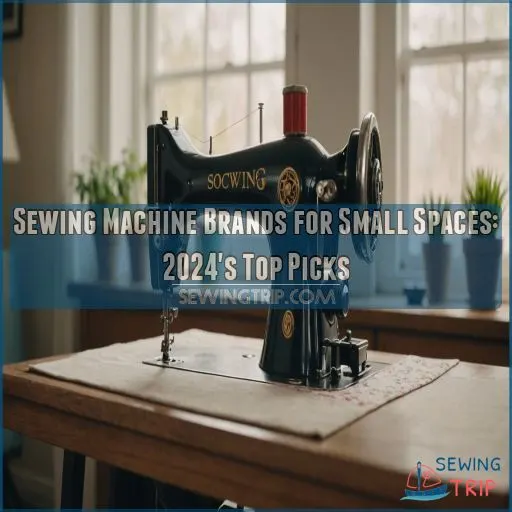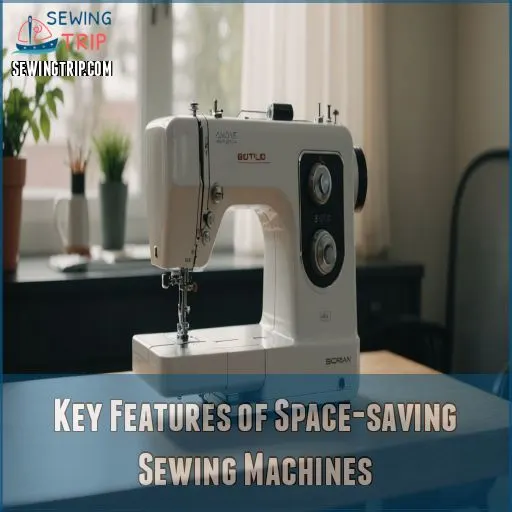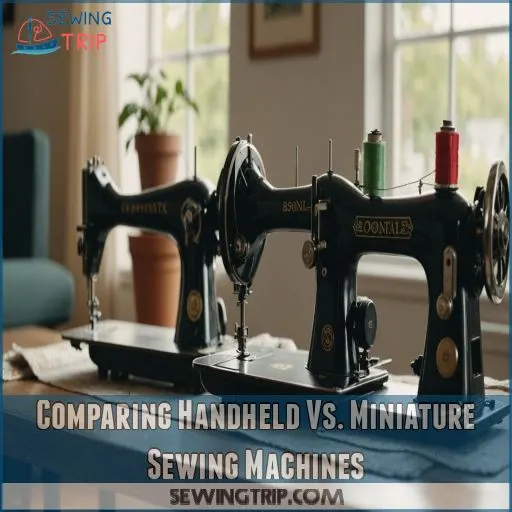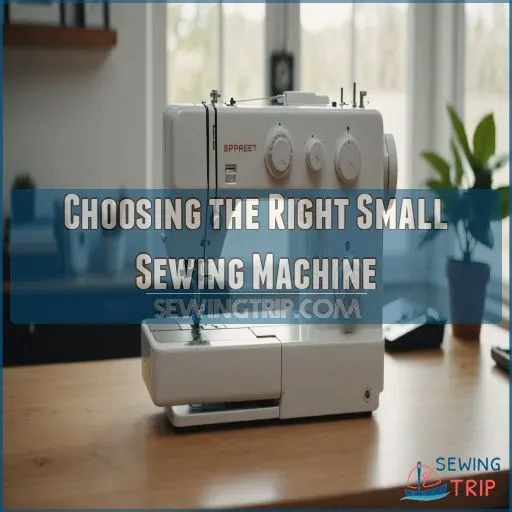This site is supported by our readers. We may earn a commission, at no cost to you, if you purchase through links.

The Janome America 001PUNCH is great overall, blending portability and power.
For a bargain, try the lightweight and chargeable iRUNTEK Handheld Mini.
Need a serger fit for a shoebox? The Juki MO-654DE Overlocker has you covered.
If quilting is your jam, the Brother CS6000i is a compact wonder.
And for a mix of tough and tiny, the SINGER Quantum Stylist 9960 stands out.
These machines promise freedom from clutter while opening up a world of creativity.
But wait—there’s more crafty wisdom ahead!
Table Of Contents
Key Takeaways
- You’ve got options galore for tiny spaces: From the portable janome america 001punch to the budget-friendly iRUNTEK Handheld Mini, there’s a machine to fit your cozy crafting corner. It’s like finding the perfect pair of jeans – snug, comfortable, and ready for action!
- Size matters, but so do features: When you’re shopping for a compact machine, don’t just focus on its footprint. Consider stitch options, buttonhole capabilities, and presser foot compatibility. It’s like packing for a weekend getaway – you want something small that still has everything you need.
- Handheld vs. miniature: It’s not just David and Goliath here. Handheld machines are great for quick fixes, while miniature ones pack more punch for bigger projects. Think of them as the difference between a Swiss Army knife and a toolbox – both useful, but for different situations.
- Your perfect match awaits: To find your ideal small sewing machine, assess your needs, space, and budget. Don’t forget to consider noise levels (your neighbors will thank you) and power sources for on-the-go sewing. It’s like dating – you’ve got to consider all aspects before committing to "the one"!
Key Features of Space-saving Sewing Machines
Finding the perfect sewing machine that fits your cozy space yet meets your needs can feel like looking for a needle in a haystack.
Size and portability are key features to consider.
We’ll guide you through key features like size, stitch options, and portability, so you won’t have to stitch up any regrets later!
Weight and Size Considerations
When you’re dealing with space limitations, you’ll find that compact sewing machines offer brilliant storage solutions.
Compact sewing machines weigh less than a hefty medieval tome, their portability impacts your freedom by allowing creativity on the move.
Embrace travel-friendly options that let you sew anywhere, anytime.
Balancing weight versus features is key—who knew choosing a sewing machine could feel like picking a trusty sidekick when considering portable sewing machines??
Stitch Options for Small Sewing Machines
When considering sewing machine dimensions, small sewing machines offer a range of stitch types—from basic stitches to advanced zigzag options.
Stitch quality and width are essential features to evaluate.
These compact sewing machines mean you can tackle various projects without cluttering your space. Imagine crafting with precision in a cozy nook, free to master each stitch type effortlessly.
Presser Feet for Compact Models
You might think a presser foot is a simple gadget, but it’s like a superhero cape for your mini sewing machine.
Choosing the right foot makes sewing smooth as butter.
Whether it’s a zigzag or walking foot, each has its charm for beginners and pros alike.
Make sure it’s compatible and easy to store so your creativity isn’t bogged down by misplaced essentials .
Buttonhole Capabilities in Small Machines
After exploring presser feet, consider buttonholes in small machines.
Sewing machine brands offer various buttonhole types, both automatic and manual.
Check these features in small-space machines, ensuring great stitch quality.
Keep an eye out for:
- Automatic Buttonholes: One-step ease.
- Buttonhole Size Variety: Choose options that suit your needs.
- Troubleshooting Capabilities: Avoid seam-stopping snags.
Happy sewing!
Carrying Handles for Portability
Though small machines boast buttonhole features, they’re not just about sewing versatility.
A solid, ergonomic handle design is your best friend when moving between sewing spaces.
Brands like Singer and Kenmore offer a sturdy grip for ease and portability, making these machines perfect for travel or tight spots.
Balancing weight and handle comfort doesn’t mean sacrificing power or quality .
Comparing Handheld Vs. Miniature Sewing Machines
When it comes to compact sewing, choosing between handheld and miniature machines can feel like picking between coffee or tea—both get the job done, but each has a unique flavor.
Handheld machines offer ultimate portability for quick fixes, while miniature machines pack slightly more power for basic projects, making your decision as simple as piecing together the right quilt for your needs.
Handheld Sewing Machine Capabilities and Limitations
If you’re thinking about a handheld sewing machine, you’ll want to weigh portability against limitations.
- Fabric Types: Best for light fabrics; avoid thick materials.
- Stitch Types: Primarily straight, lacking versatility.
- Repair vs. Craft: Perfect for quick repairs, less so for crafting.
- Durability: Portability often sacrifices durability.
Embrace convenience, but know their quirks!
Miniature Sewing Machine Features and Functionality
Just explored handheld sewing machines? Get ready to uncover the miniature sewing machine’s charm and versatility!
These compact wonders boast stitch types, adjustable thread tension, and easy bobbin loading.
Compare foot types and power options; they’re beginner-friendly too!
| Feature | Miniature Machines | Handheld Machines |
|---|---|---|
| Stitch Types | Limited | Minimal |
| Thread Tension | Adjustable | Fixed |
| Bobbin Loading | Standard | None |
| Foot Types | Multiple | Basic |
| Power Options | Electric/Battery | Battery |
Miniature sewing machines are mighty for their size!
Suitable Fabrics for Each Type
Miniature machines offer more stitch types than handhelds, tackling light to medium fabrics like cotton with ease.
Think of them like the Swiss Army knives of sewing—small but versatile.
Handhelds, on the other hand, handle simple tasks on lightweight fabrics; they’re like using a pen when you really need a typewriter .
Choose based on machine power and project complexity.
Ideal Projects for Handheld and Miniature Machines
Oftentimes, handheld and miniature sewing machines shine for quick mending tasks, sewing fabric scraps into small crafts, and stitching simple garments or basic alterations.
These compact machines excel at:
- Patching holes or rips in clothing
- Embellishing accessories like bags or pillows
- Hemming pants, skirts, or sleeves
Price Range Comparison
When you are comparing budget-friendly sewing machines, handheld models often range from $15 to $40, while affordable mini machines typically cost $40 to $80.
| Type | Price Range | Features |
|---|---|---|
| Handheld | $15 – $40 | Basic mending |
| Miniature | $40 – $80 | Multi-stitch |
Remember, a handheld option is great for quick fixes, but a mini machine offers more value for longer projects (Source).
Choosing the Right Small Sewing Machine
Finding the perfect small sewing machine involves understanding your space constraints and personal needs—you wouldn’t want to wrestle a bulky machine in a tiny apartment, right?
Whether you’re looking for quiet operation or a trusty power source for on-the-go crafting, making the right choice will make sure every stitch is a joy.
Assessing Your Sewing Needs and Space Constraints
Before diving into your first sewing project, consider your space and needs.
Do you have a nook for sewing or are you juggling tight quarters?
A compact machine can be your trusty sidekick.
Factor in the skill level, budget, and storage solutions to find the perfect fit.
Your crafty adventures start here, without hogging all your living space!
Evaluating Stitch Quality in Compact Models
Imagine sewing with a machine that feels like a smooth ride on a freshly paved road.
Stitch consistency shines when fabric tension is balanced in compact models.
Adjustable stitch length and width provide creative freedom.
Make sure your machine offers adjustable stitch length and width for creative freedom.
Quality thread makes all the difference—think of it as premium fuel for your stitching journey .
Considering Power Sources for Portability
While evaluating stitch quality, don’t overlook power sources for portability.
Battery-powered options give you cordless freedom, perfect for sewing on the go.
Some machines also offer AC adapter compatibility, ensuring you’re never stuck with dead batteries.
Compare your portable sewing machine power needs, and choose the option that best fits your lifestyle and sewing aspirations .
Comparing Noise Levels of Small Machines
Now that you’ve considered power sources, let’s chat about noise levels.
A quiet sewing machine is a dream when you’re working late or in close quarters.
Look for models with noise reduction techniques and minimal vibration.
Online sewing machine reviews can help you compare sound and make sure you have peaceful crafting sessions.
Your neighbors (and ears) will thank you!
Analyzing Durability and Warranty Options
When selecting a compact sewing machine, don’t overlook the importance of durability and warranty coverage.
Look for models backed by generous guarantees, typically 5-10 years, to protect your investment.
Check reviews on material quality, repair costs, and brand reputation – these factors can make all the difference in the long run.
Frequently Asked Questions (FAQs)
Is it worth buying a mini sewing machine?
Did you know 70% of mini sewing machine owners are beginners?
While they’re budget-friendly and portable , you’ll get what you pay for .
They’re great for small projects, but you might outgrow them quickly.
Consider your long-term sewing goals.
What is the simplest sewing machine to operate?
You’ll find the Brother XM2701 a breeze to operate.
It’s user-friendly, with simple setup and threading, plus clear instructions for beginners.
Its affordable price and basic features make it perfect for those just starting their sewing journey (Source).
Which Singer sewing machine is the easiest to use?
The Singer Start 1304 is your best bet for simplicity.
It’s a straightforward machine with basic features, perfect for beginners.
You’ll find it easy to thread and operate, with just a few essential stitches to master .
What is the best name brand sewing machine?
For beginners, Brother and Singer stand out as top sewing machine brands, especially when considering affordable prices.
Brother’s CS7000X offers user-friendly features and ample accessories , while Singer’s Heavy Duty 4423 provides affordability and versatility .
Your choice depends on specific needs and budget.
How do I organize my sewing tools efficiently?
Organize your sewing tools efficiently by investing in a tackle box for notions .
Store small items in office drawers near your workspace .
Use clear bins for fabric storage, and consider a rolling typing table for extra space.
Can sewing cabinets accommodate all machine sizes?
Picture a Cinderella slipper – not every foot fits!
Similarly, sewing cabinets come in various sizes, but they can’t accommodate all machines.
You’ll need to check the cabinet’s specifications and your machine’s dimensions for a perfect match .
Are there DIY options for sewing tables?
You’re in luck! DIY sewing tables are totally doable.
With some basic tools and materials, you can create a custom table that fits your space and needs.
From simple IKEA hacks to more advanced projects, there’s an option for every skill level .
What are the benefits of using a projector?
You’ll save time and paper by projecting patterns directly onto fabric (Source).
It’s a game-changer for quick cutting, especially with multiple sizes.
Plus, you’ll feel like a sewing superhero with this high-tech tool .
How can I maximize limited sewing time?
To maximize limited sewing time, prep your space in advance .
Set a timer for quick cleanups.
Choose patterns that require minimal adjustments .
Consider custom-sized patterns to reduce fitting time.
Organize projects for efficient workflow.
Conclusion
Picture your sewing space as a cozy nest, where creativity thrives in compact quarters.
As you’ve seen, sewing machine brands for small spaces are bursting with options.
Whether you’re drawn to the portability of handhelds or the versatility of miniature powerhouses, there’s a perfect fit for your nook.
Remember, the best machine balances your needs, space, and budget.
So, measure twice, research once, and soon you’ll be stitching up a storm in your snug sewing sanctuary.
Happy crafting, space-savvy sewists!









